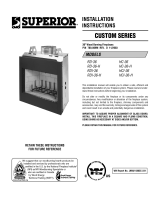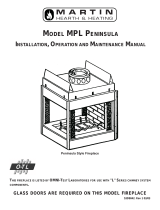
NOTE: DIAGRAMS & ILLUSTRATIONS ARE NOT TO SCALE.
2
TABLE OF CONTENTS
Safety Rules ......................................Page 2
Tools and Building Supplies ..............Page 2
Precautions .......................................Page 2
Introduction ......................................Page 3
Clearances/Height Requirements ......Page 4
Chimney System ...............................Page 4
Assembly Outline ..............................Page 4
Location of Fireplace .........................Page 5
Clearances ........................................Page 5
Assembly Steps ................................Page 6
Preinstallation Notes .........................Page 6
Waterproofi ng Fireplace ....................Page 6
Outside Air Kit .................................Page 6
Fireplace & Framing Specifi cations ...Page 9
Installing the Fireplace ......................Page 10
Installing the Chimney System ..........Page 12
30° Offset through Floor/Ceiling .......Page 13
Ten Foot Rule Summary ....................Page 15
Multiple Terminations .......................Page 15
Chimney Component Calculations ....Page 15
Special Offset Instructions ................Page 15
Offset Calculations ............................Page 16
Vertical Elevation Charts ..................Page 15
Installing Offsets ...............................Page 16
Offset Elevation Chart ........................Page 18
Gas Line Connection .........................Page 18
Vent Free Appliances .........................Page 19
Glass Doors ......................................Page 19
Cold Climate Insulation .....................Page 20
Fireplace Finishes - Mantels and Trim ..Page 20
Hearth Extensions/Wall Shields ........Page 20
Finish Requirements .........................Page 22
Installation Components ...................Page 23
PLEASE READ AND
UNDERSTAND THESE
IMPORTANT SAFETY RULES.
• The manufacturer is not responsible for any
smoking or related problems that may result
from the lack of adequate combustion air. It
is the responsibility of the builder/contractor
to ensure that adequate combustion air has
been provided for the fi replace.
• An Outside Air Cover (provided) or an Out-
side Air Kit Gate, model OAKG-OD (optional)
must be installed to prevent signifi cant cold
air infi ltration.
13. Always ensure that the air inlet to the fi replace
is free from debris and any other obstructions
that can block the entrance of air.
14. DO NOT use a fi replace insert or any other
product not specifi ed by Lennox for use
with this fi replace. All gas log sets must
be operated with the damper clamped open,
including unlisted “vent free” log sets. Listed
“vent-free” log sets may be operated with
the damper closed.
15."Smoke free” operation is not warranteed
nor are we responsible for inadequate sys-
tem draft, general construction conditions,
inadequate chimney heights, adverse wind
conditions and/or unusual environmental
factors or conditions beyond our control.
16.Never, under any circumstances, install a
fi replace, chimney component or any acces-
sories, that has visible or suspected physical
damage as a result of handling or transporta-
tion. These items should be inspected by your
distributor or qualifi ed factory representative
to ensure safe condition. When in doubt,
consult your distributor.
17. For additional safety considerations and
complete operating instructions, refer to
the Care and Operation Manual provided
with the fi replace.
1. Before starting your fi replace installation,
read these installation instructions carefully
to be sure you understand them completely
and in entirety. Failure to follow them could
cause a fi replace malfunction resulting in
serious injury and/or property damage.
2. Always check your local building codes.
The installation must comply with all lo-
cal, regional, state and national codes and
regulations.
3. This fi replace must be installed with Security
Chimneys FTF8 [8" (203mm) inside diam-
eter] Chimney System only. This fi replace is
intended for indoor or outdoor installations.
The chimney system must always vent to
the outside of the building or structure.
4. To ensure a safe fi replace system and to
prevent the build-up of soot and creosote,
inspect and clean the fi replace and chimney
prior to use and periodically during the heat-
ing season.
5. Burn approved fuels only as defi ned in the
Homeowner's Care and Operation Manual.
6. NEVER use gasoline, gasoline-type lantern
fuel, kerosene, charcoal lighter fl uid, or
similar liquids to start or “freshen up” a fi re
in this fi replace. Keep any fl ammable liquids
at safe distance from the fi replace.
7. NEVER leave children unattended when there
is a fi re burning in the fi replace.
8. Always keep fl ue damper open when heat is
present in the fi replace.
9. Before servicing, allow the fi replace to cool.
Always shut off any gas to the fi replace
while working on it. This will prevent the
possibility of burns.
10.This fi replace is not a heater. It is designed
to ensure homeowner comfort by providing
supplemental heat to its immediate area.
11. Keep screens closed after feeding fi re to
keep embers from fl ying out ot fi replace.
12.INDOOR INSTALLATIONS:
• Always ensure that an adequate supply
of replacement combustion air from the
outside of the house is accessible to the fi re
to support normal combustion. Fireplaces
consume large volumes of air during the
normal combustion process.
• In the event the home is tightly sealed
with modern energy effi cient features, the
optional outside air kit may not provide all
the air required to support combustion.
PACKAGING
The assembled indoor/outdoor fi replace is
packaged with:
1 - One envelope containing the literature pack-
age which consists of the homeowner's
manual, installation instructions, warranty
and combustion air cover (located in the
fi rebox).
2 - One Outside Air Kit.
3 - Hearth Extension Strips.
WARNING
To avoid the risk of damaging
fi replace materials and increas-
ing the risk of fi re, do not use the
fi replace to cook or warm food.
AVERTISSEMENT
Pour éviter le risque
d’endommager les matériaux
du foyer et d’augmenter le
risque d’incendie, n’employez
pas le foyer pour faire cuire ou
réchauffer de la nourriture.
TOOLS AND BUILDING SUPPLIES
NORMALLY REQUIRED
Tools Supplies
Phillips screwdriver
Hammer
Saw and/or sabersaw
Level
Measuring tape
Plumb line
Electric drill and bits
Pliers
Square
Framing materials
Wall fi nishing materials
Caulking materials
(noncombustible)
Fireplace surround and
hearth extension
materials
(noncombustible)
PRECAUTIONS
The most important areas of concern dealing
with the installation of factory-built fi replaces
are clearances to combustible materials, proper
assembly of component parts, height of the
chimney system, the proper use of accessories
supplied by the manufacturer and the techniques
employed in using fi nishing materials applied to
the wall surrounding the fi replace, hearth exten-
sions and wall shields. Each of these topics will
be covered in thorough detail throughout this
manual. Please give each your special attention
as you progress with your installation.
























